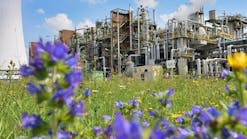Gazprom Neft’s Omsk refinery producing IMO 2020-compliant fuels
PJSC Gazprom Neft has started production of low-sulfur fuels that comply with the International Marine Organization’s (IMO) new regulations requiring ships to use marine fuels with a sulfur content below 0.5% at its 430,000-b/d Omsk refinery in Western Siberia.
The refinery began production of its new and proprietary RME-180 M-grade marine fuel—which has a sulfur content below 0.5%—in January 2020, with the first consignment of the environmentally-friendly fuel taken onboard the Italian Ice Point tanker by a Gazprom Neft-Omsk bunkering vessel as of Feb. 17, Gazprom Neft said.
Designed for two-stroke and four-stroke engines, RME-180 M-grade marine fuel includes hydrotreated gas oil components, according to the operator.
Start of RME-180 M-grade marine fuel production at Omsk follows work completed as part of the operator’s second phase of its ongoing modernization program to reduce environmental impacts and improve processing capacities, conversion rates, energy efficiency, and production qualities at the site (OGJ Online, Nov. 18, 2019; Feb. 15, 2018).
Work to enable production of the IMO-compliant fuel specifically included installation of 3.5 km of pipelines to transport marine-fuel components to the mixing and shipment facility, as well as installation of on-stream analyzers at the mixing facility to monitor product quality in real time, Gazprom Neft said.
The Omsk refinery began production of an environmentally friendly marine fuel with a sulfur content of less than 0.1% in 2017 for use within sulfur emissions control area (SECA) navigation zones ahead of new IMO regulations lowering the maximum sulfur content of marine fuel oil used in ocean-going vessels to below 0.5%—down from a previous 3.5%—that took effect on Jan. 1, 2020, according to an Oct. 12, 2017, release from the company.
While the operator did not disclose current production levels for RME-180 M-grade fuel at Omsk, Gazprom Neft said its system-wide total supply of IMO-compliant fuels could exceed 1.5 million tonnes by yearend.
Ongoing modernization works
Earlier in February, Gazprom Neft also confirmed it had completed installation of major technology equipment at the construction site for a new primary crude refining complex at the Omsk refinery.
Alongside forming a key part of the second phase of the Omsk refinery’s modernization program, the new crude complex at Omsk also comes as part of the Russian federal government’s master plan for its Clean Air and Ecology projects adopted under a decree from President Vladimir Putin in May 2018, the operator said.
As of Feb. 7, installation of new atmospheric and vacuum distillation columns with a combined total weight of 1,200 tonnes was completed, as was construction of all foundations and reinforced concrete structures, Gazprom Neft said.
Installation of underground services and utilities, pipelines, and automated control systems as part of the project remains ongoing.
With a production capacity of 8.4 million tonnes/year, the new complex will feature a suite of technologies designed to reduce emissions at the site, including ongoing monitoring of environmental impacts as well as a closed-loop equipment drainage system that will allow recoverable oil products to be sent for recycling.
Following startup of the new complex, Gazprom Neft also will decommission six existing but obsolete units at the refinery, further reducing the site’s overall environmental footprint, the company said.
Construction of the primary crude refining complex—which will require a total investment of more than 50 billion rubles—is scheduled to be completed by 2021.

Robert Brelsford | Downstream Editor
Robert Brelsford joined Oil & Gas Journal in October 2013 as downstream technology editor after 8 years as a crude oil price and news reporter on spot crude transactions at the US Gulf Coast, West Coast, Canadian, and Latin American markets. He holds a BA (2000) in English from Rice University and an MS (2003) in education and social policy from Northwestern University.

